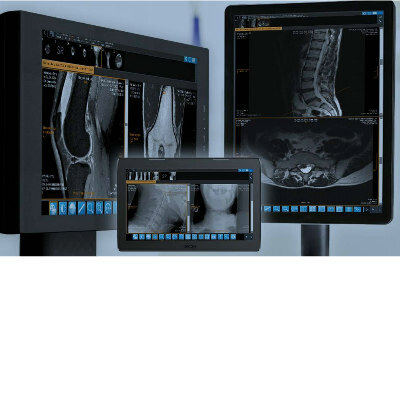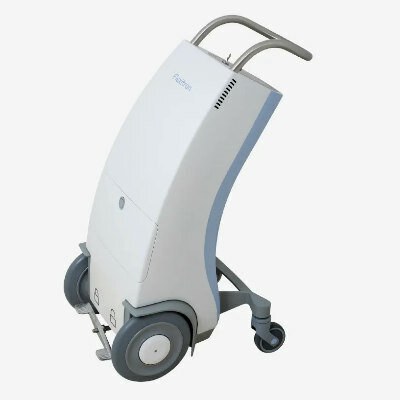Raman Spectroscopy Reveals Tumor Resistance to Radiation
|
By MedImaging International staff writers Posted on 27 May 2019 |

Image: A new study suggests that Raman spectroscopy can help identify a tumor’s resistance to RT (Photo courtesy of JHU).
A new study suggests that Raman spectroscopy can identify subtle differences in a tumor’s biochemical environment that correlate with its susceptibility to radiation therapy (RT).
Researchers at Johns Hopkins University (JHU; Baltimore, MD, USA) and the University of Arkansas (UARK; Fayetteville, AR, USA) conducted a murine study to reveal biomolecular changes in tumors induced by radiation, and uncover the latent differences that separate RT-resistant and RT-sensitive tumors. To do so, they grew tumor xenografts in athymic nude mice and quantified the Raman spectroscopic tissue assessments in both untreated and treated tumors by chemometric analysis of the biomolecular differences in the tumor microenvironment.
They found that Raman spectroscopy measurements revealed significant and reliable differences in lipid and collagen content post-radiation in the tumor microenvironment, with consistently greater changes observed in the RT-sensitive tumors. Based on the findings, they then created an algorithm to identify the difference between RT-resistant and nonresistant tumors, and validated it by applying the Raman technique to untreated tumors. The algorithm separated them into RT-sensitive and resistant categories with a success rate of 97%. The study was published on February 28, 2019, in Cancer Research.
“In addition to accurately evaluating tumor response to therapy, the combination of Raman spectral markers potentially offers a route to predicting response in untreated tumors prior to commencing treatment,” concluded lead author Santosh Paidi, MSc, of JHU, and colleagues. “Combined with its non-invasive nature, our findings provide a rationale for in vivo studies using Raman spectroscopy, with the ultimate goal of clinical translation for patient stratification and guiding adaptation of radiotherapy during the course of treatment.”
"This is only the first step of a larger research endeavor to determine how head and neck cancer tumors respond to radiation,” said senior author mechanical engineer Ishan Barman, PhD, of JHU. “The ultimate goal is to build a miniature probe that can fit into a laryngoscope. Hopefully in the future, then, when a clinician performs an endoscopy and looks at a patient's cancerous tumor, they'll be able to determine whether that tumor will even respond to radiation therapy, and that can improve treatment plans.”
Raman spectroscopy is a form of molecular spectroscopy based on Raman scattering. When a beam of light interacts with a material, part of it is transmitted, part it is reflected, and part of it is scattered; over 99% of the scattered radiation has the same frequency as the incident beam, but a small portion of the scattered radiation has frequencies different from that of the incident beam. The scattered radiation contains information on the particular atoms or ions that comprise the molecule, the chemical bonds connect them, the symmetry of their molecule structure, and the physico-chemical environment where they reside.
Related Links:
Johns Hopkins University
University of Arkansas
Researchers at Johns Hopkins University (JHU; Baltimore, MD, USA) and the University of Arkansas (UARK; Fayetteville, AR, USA) conducted a murine study to reveal biomolecular changes in tumors induced by radiation, and uncover the latent differences that separate RT-resistant and RT-sensitive tumors. To do so, they grew tumor xenografts in athymic nude mice and quantified the Raman spectroscopic tissue assessments in both untreated and treated tumors by chemometric analysis of the biomolecular differences in the tumor microenvironment.
They found that Raman spectroscopy measurements revealed significant and reliable differences in lipid and collagen content post-radiation in the tumor microenvironment, with consistently greater changes observed in the RT-sensitive tumors. Based on the findings, they then created an algorithm to identify the difference between RT-resistant and nonresistant tumors, and validated it by applying the Raman technique to untreated tumors. The algorithm separated them into RT-sensitive and resistant categories with a success rate of 97%. The study was published on February 28, 2019, in Cancer Research.
“In addition to accurately evaluating tumor response to therapy, the combination of Raman spectral markers potentially offers a route to predicting response in untreated tumors prior to commencing treatment,” concluded lead author Santosh Paidi, MSc, of JHU, and colleagues. “Combined with its non-invasive nature, our findings provide a rationale for in vivo studies using Raman spectroscopy, with the ultimate goal of clinical translation for patient stratification and guiding adaptation of radiotherapy during the course of treatment.”
"This is only the first step of a larger research endeavor to determine how head and neck cancer tumors respond to radiation,” said senior author mechanical engineer Ishan Barman, PhD, of JHU. “The ultimate goal is to build a miniature probe that can fit into a laryngoscope. Hopefully in the future, then, when a clinician performs an endoscopy and looks at a patient's cancerous tumor, they'll be able to determine whether that tumor will even respond to radiation therapy, and that can improve treatment plans.”
Raman spectroscopy is a form of molecular spectroscopy based on Raman scattering. When a beam of light interacts with a material, part of it is transmitted, part it is reflected, and part of it is scattered; over 99% of the scattered radiation has the same frequency as the incident beam, but a small portion of the scattered radiation has frequencies different from that of the incident beam. The scattered radiation contains information on the particular atoms or ions that comprise the molecule, the chemical bonds connect them, the symmetry of their molecule structure, and the physico-chemical environment where they reside.
Related Links:
Johns Hopkins University
University of Arkansas
Latest Nuclear Medicine News
- New SPECT/CT Technique Could Change Imaging Practices and Increase Patient Access
- New Radiotheranostic System Detects and Treats Ovarian Cancer Noninvasively
- AI System Automatically and Reliably Detects Cardiac Amyloidosis Using Scintigraphy Imaging
- Early 30-Minute Dynamic FDG-PET Acquisition Could Halve Lung Scan Times
- New Method for Triggering and Imaging Seizures to Help Guide Epilepsy Surgery
- Radioguided Surgery Accurately Detects and Removes Metastatic Lymph Nodes in Prostate Cancer Patients
- New PET Tracer Detects Inflammatory Arthritis Before Symptoms Appear
- Novel PET Tracer Enhances Lesion Detection in Medullary Thyroid Cancer
- Targeted Therapy Delivers Radiation Directly To Cells in Hard-To-Treat Cancers
- New PET Tracer Noninvasively Identifies Cancer Gene Mutation for More Precise Diagnosis
- Algorithm Predicts Prostate Cancer Recurrence in Patients Treated by Radiation Therapy
- Novel PET Imaging Tracer Noninvasively Identifies Cancer Gene Mutation for More Precise Diagnosis
- Ultrafast Laser Technology to Improve Cancer Treatment
- Low-Dose Radiation Therapy Demonstrates Potential for Treatment of Heart Failure
- New PET Radiotracer Aids Early, Noninvasive Detection of Inflammatory Bowel Disease
- Combining Amino Acid PET and MRI Imaging to Help Treat Aggressive Brain Tumors
Channels
Radiography
view channel
Novel Breast Imaging System Proves As Effective As Mammography
Breast cancer remains the most frequently diagnosed cancer among women. It is projected that one in eight women will be diagnosed with breast cancer during her lifetime, and one in 42 women who turn 50... Read more
AI Assistance Improves Breast-Cancer Screening by Reducing False Positives
Radiologists typically detect one case of cancer for every 200 mammograms reviewed. However, these evaluations often result in false positives, leading to unnecessary patient recalls for additional testing,... Read moreMRI
view channel
PET/MRI Improves Diagnostic Accuracy for Prostate Cancer Patients
The Prostate Imaging Reporting and Data System (PI-RADS) is a five-point scale to assess potential prostate cancer in MR images. PI-RADS category 3 which offers an unclear suggestion of clinically significant... Read more
Next Generation MR-Guided Focused Ultrasound Ushers In Future of Incisionless Neurosurgery
Essential tremor, often called familial, idiopathic, or benign tremor, leads to uncontrollable shaking that significantly affects a person’s life. When traditional medications do not alleviate symptoms,... Read more
Two-Part MRI Scan Detects Prostate Cancer More Quickly without Compromising Diagnostic Quality
Prostate cancer ranks as the most prevalent cancer among men. Over the last decade, the introduction of MRI scans has significantly transformed the diagnosis process, marking the most substantial advancement... Read moreUltrasound
view channel
Deep Learning Advances Super-Resolution Ultrasound Imaging
Ultrasound localization microscopy (ULM) is an advanced imaging technique that offers high-resolution visualization of microvascular structures. It employs microbubbles, FDA-approved contrast agents, injected... Read more
Novel Ultrasound-Launched Targeted Nanoparticle Eliminates Biofilm and Bacterial Infection
Biofilms, formed by bacteria aggregating into dense communities for protection against harsh environmental conditions, are a significant contributor to various infectious diseases. Biofilms frequently... Read moreGeneral/Advanced Imaging
view channel
New AI Method Captures Uncertainty in Medical Images
In the field of biomedicine, segmentation is the process of annotating pixels from an important structure in medical images, such as organs or cells. Artificial Intelligence (AI) models are utilized to... Read more.jpg)
CT Coronary Angiography Reduces Need for Invasive Tests to Diagnose Coronary Artery Disease
Coronary artery disease (CAD), one of the leading causes of death worldwide, involves the narrowing of coronary arteries due to atherosclerosis, resulting in insufficient blood flow to the heart muscle.... Read more
Novel Blood Test Could Reduce Need for PET Imaging of Patients with Alzheimer’s
Alzheimer's disease (AD), a condition marked by cognitive decline and the presence of beta-amyloid (Aβ) plaques and neurofibrillary tangles in the brain, poses diagnostic challenges. Amyloid positron emission... Read more.jpg)
CT-Based Deep Learning Algorithm Accurately Differentiates Benign From Malignant Vertebral Fractures
The rise in the aging population is expected to result in a corresponding increase in the prevalence of vertebral fractures which can cause back pain or neurologic compromise, leading to impaired function... Read moreImaging IT
view channel
New Google Cloud Medical Imaging Suite Makes Imaging Healthcare Data More Accessible
Medical imaging is a critical tool used to diagnose patients, and there are billions of medical images scanned globally each year. Imaging data accounts for about 90% of all healthcare data1 and, until... Read more
Global AI in Medical Diagnostics Market to Be Driven by Demand for Image Recognition in Radiology
The global artificial intelligence (AI) in medical diagnostics market is expanding with early disease detection being one of its key applications and image recognition becoming a compelling consumer proposition... Read moreIndustry News
view channel
Bayer and Google Partner on New AI Product for Radiologists
Medical imaging data comprises around 90% of all healthcare data, and it is a highly complex and rich clinical data modality and serves as a vital tool for diagnosing patients. Each year, billions of medical... Read more





















